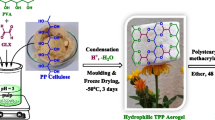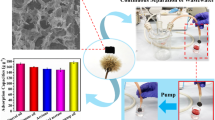Abstract
Oily wastewater pollution is an urgent problem to be solved. Complicated preparation process, toxic hydrophobic modifiers and poor mechanical properties limit the application of polysaccharide-based aerogel in oil–water separation. Inspired by the Strider’s Leg structure in nature, an eco-friendly and reusable polysaccharide-based composite aerogel was prepared by hydrophobic modification with zein for efficient oil–water separation. The introduction of hydrophobic zein into aerogel by simple immersion method without the use of toxic modifiers can build micro/nanostructures similar to the villi on a water strider’s leg to increase the surface roughness and the hydrophobicity. And three degradable, non-toxic and economical polysaccharides including chitosan, carboxylated cellulose nanofibers and starch were used to construct aerogel skeleton, endowing aerogel with porous structures and good mechanical properties. The resulting composite aerogel (ZOMA) showed low density (0.11 g/cm3), good oil absorption capacity (9 g/g), high flux oil–water separation (5595 L m−2 h−1) and excellent oil–water separation performance (99.8%). And ZOMA still had good tensile strength and elasticity after 50 compression cycles. After 10 cycles of absorption and desorption, ZOMA aerogel remained still more than 90% of its initial absorption capacity. This study provides new insight for the design of environmentally friendly and efficient adsorbents for oil–water separation.









Similar content being viewed by others
Data Availability
The data that support the findings of this article are avaible in Journal of Bionic Engineering webstite (Springer) with the DOI of the article.
References
Yang, Y., Li, X. J., Zheng, X., Chen, Z. Y., Zhou, Q. F., & Chen, Y. (2018). 3D-printed biomimetic super-hydrophobic structure for microdroplet manipulation and oil/water separation. Advanced Materials, 30, 1704912.
Fu, Y., & Guo, Z. G. (2022). Natural polysaccharide-based aerogels and their applications in oil–water separations: A review. Journal of Materials Chemistry A, 10, 8129–8158.
Xu, C. L., Luo, Y. T., Zhou, L., Bi, Y. W., & Sun, H. (2022). Fabrication of durable superhydrophobic stainless steel mesh with nano/micro flower-like morphologies for self-cleaning and efficient oil/water separation. Journal of Bionic Engineering, 19, 1615–1624.
Tian, Y. L., Feng, J. K., Cai, Z. X., Chao, J. Q., Zhang, D. W., Cui, Y. X., & Chen, F. (2021). Dodecyl mercaptan functionalized copper mesh for water repellence and oil-water separation. Journal of Bionic Engineering, 18, 887–899.
Wang, Y. X., Su, Y. H., Wang, W. L., Fang, Y., Riffat, S. B., & Jiang, F. T. (2019). The advances of polysaccharide-based aerogels: Preparation and potential application. Carbohydrate Polymers, 226, 115242.
Ziegler, C., Wolf, A., Liu, W., Herrmann, A. K., Gaponik, N., & Eychmuller, A. (2017). Modern inorganic aerogels. Angewandte Chemie International Edition, 56, 13200–13221.
Wang, W., Dong, C. X., Liu, S. R., Zhang, Y. H., Kong, X. Q., Wang, M., Ding, C., Liu, T. Y., Shen, H. L., & Bi, H. C. (2023). Super-hydrophobic cotton aerogel with ultra-high flux and high oil retention capability for efficient oil/water separation. Colloids and Surfaces A: Physicochemical and Engineering Aspects, 657, 130572.
Wang, N. N., Wang, H., Wang, Y. Y., Wei, Y. H., Si, J. Y., Yuen, A. C. Y., Xie, J. S., Yu, B., Zhu, S. E., Lu, H. D., Yang, W., Chan, Q. N., & Yeoh, G. H. (2019). Robust, lightweight, hydrophobic, and fire-retarded polyimide/MXene aerogels for effective oil/water separation. ACS Applied Materials and Interfaces, 11, 40512–40523.
Delbianco, M., & Seeberger, P. H. (2020). Materials science based on synthetic polysaccharides. Materials Horizons, 7, 963–969.
Yang, W.-J., Yuen, A. C. Y., Li, A., Lin, B., Chen, T. B. Y., Yang, W., Lu, H.-D., & Yeoh, G. H. (2019). Recent progress in bio-based aerogel absorbents for oil/water separation. Cellulose, 26, 6449–6476.
Zhang, Y., Yin, M. L., Li, L., Fan, B. J., Liu, Y., Li, R., Ren, X. H., Huang, T. S., & Kim, I. S. (2020). Construction of aerogels based on nanocrystalline cellulose and chitosan for high efficient oil/water separation and water disinfection. Carbohydrate Polymers, 243, 116461.
Qin, H. F., Zhang, Y. F., Jiang, J. G., Wang, L. L., Song, M. Y., Bi, R., Zhu, P. H., & Jiang, F. (2021). Multifunctional superelastic cellulose nanofibrils aerogel by dual ice-templating assembly. Advanced Functional Materials, 31, 2106269.
Zhang, M. L., Jiang, S., Han, F. Y., Li, M. M., Wang, N., & Liu, L. F. (2021). Anisotropic cellulose nanofiber/chitosan aerogel with thermal management and oil absorption properties. Carbohydrate Polymers, 264, 118033.
Dong, T., Tian, N., Xu, B., Huang, X. H., Chi, S., Liu, Y. M., Lou, C.-W., & Lin, J.-H. (2022). Biomass poplar catkin fiber-based superhydrophobic aerogel with tubular-lamellar interweaved neurons-like structure. Journal of Hazardous Materials, 429, 128290.
Mulyadi, A., Zhang, Z., & Deng, Y. (2016). Fluorine-free oil absorbents made from cellulose nanofibril aerogels. ACS Applied Materials and Interfaces, 8, 2732–2740.
Kasaai, M. R. (2018). Zein and zein-based nano-materials for food and nutrition applications: A review. Trends in Food Science & Technology, 79, 184–197.
Yu, X., Li, C. M., Tian, H. F., Yuan, L., Xiang, A. M., Li, J. L., Wang, C. Y., & Rajulu, A. V. (2020). Hydrophobic cross-linked zein-based nanofibers with efficient air filtration and improved moisture stability. Chemical Engineering Journal, 396, 125373.
Gao, X. F., & Jiang, L. (2004). Water-repellent legs of water striders. Nature, 432(7013), 36–36.
Zhu, F. (2019). Starch based aerogels: Production, properties and applications. Trends in Food Science & Technology, 89, 1–10.
Zhao, J., Xi, X. T., Ouyang, H., Yang, J. Y., Wang, Y., Yi, L. F., Song, D. Y., Song, Y. J., & Zhao, L. J. (2021). Acidic and alkaline gas sensitive and self-healing chitosan aerogel based on electrostatic interaction. Carbohydrate Polymers, 272, 118445.
Wang, H., Kong, L. Y., & Ziegler, G. R. (2019). Fabrication of starch-nanocellulose composite fibers by electrospinning. Food Hydrocolloids, 90, 90–98.
Zhang, F., Chi, H., Wang, C., Wang, X. Y., Wang, Y. C., Zhang, H., Xu, K., Bai, Y. G., & Wang, P. X. (2021). Multifunctional starch-based material for contaminated emulsions separation and purification. Carbohydrate Polymers, 269, 118354.
Wang, Y., & Padua, G. W. (2012). Nanoscale characterization of zein self-assembly. Langmuir, 28, 2429–2435.
Ma, X. T., Lou, Y., Chen, X.-B., Shi, Z., & Xu, Y. (2019). Multifunctional flexible composite aerogels constructed through in-situ growth of metal-organic framework nanoparticles on bacterial cellulose. Chemical Engineering Journal, 356, 227–235.
Jimenez-Saelices, C., Seantier, B., Cathala, B., & Grohens, Y. (2017). Spray freeze-dried nanofibrillated cellulose aerogels with thermal superinsulating properties. Carbohydrate Polymers, 157, 105–113.
Zhang, Z., Tan, J. W., Gu, W. H., Zhao, H. Q., Zheng, J., Zhang, B. S., & Ji, G. (2020). Cellulose-chitosan framework/polyailine hybrid aerogel toward thermal insulation and microwave absorbing application. Chemical Engineering Journal, 395, 125190.
Huang, J. Y., Li, D. W., Zhao, M., Ke, H. Z., Mensah, A., Lv, P., Tian, X. J., & Wei, Q. F. (2019). Flexible electrically conductive biomass-based aerogels for piezoresistive pressure/strain sensors. Chemical Engineering Journal, 373, 1357–1366.
Zhang, G. H., Liu, Y., Chen, C., Long, L., He, J. S., Tian, D., Luo, L., Yang, G., Zhang, X. H., & Zhang, Y. Z. (2022). MOF-based cotton fabrics with switchable superwettability for oil–water separation. Chemical Engineering Science, 256, 117695.
Liu, Q., Yu, H. H., Zeng, F. M., Li, X., Sun, J., Li, C., Lin, H., & Su, Z. M. (2021). HKUST-1 modified ultrastability cellulose/chitosan composite aerogel for highly efficient removal of methylene blue. Carbohydrate Polymers, 255, 117402.
Li, Z. D., Zhong, L., Zhang, T., Qiu, F. X., Yue, X. J., & Yang, D. Y. (2019). Sustainable, flexible, and superhydrophobic functionalized cellulose aerogel for selective and versatile oil/water separation. ACS Sustainable Chemistry & Engineering, 7, 9984–9994.
He, J., Zhao, H. Y., Li, X. L., Su, D., Zhang, F. R., Ji, H. M., & Liu, R. (2018). Superelastic and superhydrophobic bacterial cellulose/silica aerogels with hierarchical cellular structure for oil absorption and recovery. Journal of Hazardous Materials, 346, 199–207.
Zanini, M., Lavoratti, A., Lazzari, L. K., Galiotto, D., Pagnocelli, M., Baldasso, C., & Zattera, A. J. (2016). Producing aerogels from silanized cellulose nanofiber suspension. Cellulose, 24, 769–779.
Huang, J. K., & Yan, Z. F. (2018). Adsorption mechanism of oil by resilient graphene aerogels from oil-water emulsion. Langmuir, 34, 1890–1898.
Wang, R., Zhu, L., Zhu, X., Yan, Z. C., Xia, F. J., Zhang, J. Q., Liu, X. L., Yu, J. P., & Xue, Q. Z. (2023). A super-hydrophilic and underwater super-oleophobic membrane with robust anti-fouling performance of high viscous crude oil for efficient oil/water separation. Colloids and Surfaces A: Physicochemical and Engineering Aspects, 658, 130662.
Dilamian, M., & Noroozi, B. (2021). Rice straw agri-waste for water pollutant adsorption: Relevant mesoporous super hydrophobic cellulose aerogel. Carbohydrate Polymers, 251, 117016.
Chen, X. M., Weibel, J. A., & Garimella, S. V. (2016). Continuous oil–water separation using polydimethylsiloxane-functionalized melamine sponge. Industrial & Engineering Chemistry Research, 55, 3596–3602.
Saini, H., Otyepková, E., Schneemann, A., Zbořil, R., Otyepka, M., Fischer, R. A., & Jayaramulu, K. (2022). Hierarchical porous metal–organic framework materials for efficient oil–water separation. Journal of Materials Chemistry A, 10, 2751–2785.
Horvat, G., Fajfar, T., Perva Uzunalić, A., Knez, Ž, & Novak, Z. (2016). Thermal properties of polysaccharide aerogels. Journal of Thermal Analysis and Calorimetry, 127, 363–370.
Jiang, S. H., Uch, B., Agarwal, S., & Greiner, A. (2017). Ultralight, thermally insulating, compressible polyimide fiber assembled sponges. ACS Applied Materials and Interfaces, 9, 32308–32315.
Wang, H. L., Zhang, X., Wang, N., Li, Y., Feng, X., Huang, Y., Zhao, C. S., Liu, Z. L., Fang, M. H., Ou, G., Gao, H. J., Li, X. Y., & Wu, H. (2017). Ultralight, scalable, and high-temperature–resilientceramic nanofiber sponges. Science advances, 3(6), e1603170.
Acknowledgements
This work is supported by the National Nature Science Foundation of China (no. 51735013).
Author information
Authors and Affiliations
Corresponding authors
Ethics declarations
Conflict of interest
The authors declare no conflict of interest/competing interests.
Additional information
Publisher's Note
Springer Nature remains neutral with regard to jurisdictional claims in published maps and institutional affiliations.
Supplementary Information
Below is the link to the electronic supplementary material.
Rights and permissions
Springer Nature or its licensor (e.g. a society or other partner) holds exclusive rights to this article under a publishing agreement with the author(s) or other rightsholder(s); author self-archiving of the accepted manuscript version of this article is solely governed by the terms of such publishing agreement and applicable law.
About this article
Cite this article
Fu, Y., Ai, S., Guo, Z. et al. Nature-inspired Polysaccharide-based Aerogel for Oil–water Separation. J Bionic Eng 20, 1956–1966 (2023). https://doi.org/10.1007/s42235-023-00370-w
Received:
Revised:
Accepted:
Published:
Issue Date:
DOI: https://doi.org/10.1007/s42235-023-00370-w




